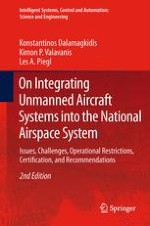This book presents, in a comprehensive way, current unmanned aviation regulation, airworthiness certification, special aircraft categories, pilot certification, federal aviation requirements, operation rules, airspace classes and regulation development models.
It discusses unmanned aircraft systems levels of safety derived mathematically based on the corresponding levels for manned aviation. It provides an overview of the history and current status of UAS airworthiness and operational regulation worldwide. Existing regulations have been developed considering the need for a complete regulatory framework for UAS. It focuses on UAS safety assessment and functional requirements, achieved in terms of defining an “Equivalent Level of Safety”, or ELOS, with that of manned aviation, specifying what the ELOS requirement entails for UAS regulations. To accomplish this, the safety performance of manned aviation is first evaluated, followed by a novel model to derive reliability requirements for achieving target levels of safety (TLS) for ground impact and mid-air collision accidents.It discusses elements of a viable roadmap leading to UAS integration in to the NAS.
For this second edition of the book almost all chapters include major updates and corrections. There is also a new appendix chapter.
